Reading note names in music is not hard. With this complete guide, you can learn everything you need to know to help you get started reading music.
Learning to read music is an essential part of mastering any instrument. It allows you to not only read the notes that you are playing, but to read the music that other people are playing.
Here is everything you need to know about the different note names you will come across when learning how to read music.
- Reading note names in music is not hard. With this complete guide, you can learn everything you need to know to help you get started reading music.
- What are Note Names in Music?
- What are Music Notes?
- Who Invented Note Names?
- What is Solfège?
- Why Learn Note Names?
- What is the Musical Alphabet?
- What is Pitch?
- What is the Music Staff?
- What are Space Notes?
- What are Line Notes?
- Clef Signs
- Why Use Multiple Clefs?
- Treble Clef Sign
- What are the Note Names for the Treble Clef?
- What are the Note Names for the Lines in Treble Clef?
- What are the Note Names of the Spaces of the Treble Clef?
- Which Instruments Use the Treble Clef?
- Bass Clef Sign
- What are the Note Names for the Bass Clef?
- What are the Note Names for the Lines in Bass Clef?
- What are the Note Names of the Spaces of the Bass Clef?
- Which Instruments Use the Bass Clef?
- C Clefs
- Alto Clef
- Tenor Clef
- What is the Grand Staff?
- Grand Staff Note Names
- What are Ledger Lines?
- Ledger Line Note Names
- Treble Clef Ledger Line Note Names
- Bass Clef Ledger Line Note Names
- Grand Staff Ledger Line Notes
- What are the Note Names on a Piano?
- What are Half Steps?
- What are Accidentals?
- What are Sharps?
- What are Flats?
- What are Enharmonic Notes?
- What are Naturals?
- What are Double Sharps?
- What are Double Flats?
- Enharmonic Notes on the Piano
- What are Whole Steps?
- What is a Scale?
- What is Melody?
- What is a Key?
- How Many Note Names are There?
- How to Remember Note Names
- Common Mnemonics for Treble Clef Line Notes
- Common Mnemonics for Treble Clef Space Notes
- Common Mnemonics for Bass Clef Line Notes
- Common Mnemonics for Bass Clef Space Notes
- How to Memorize Note Names
- At What Point Should I Stop Writing in the Note Names for Music Pieces?
- Reading Note Names in Music Summary
What are Note Names in Music?
The names for music notes use the 7 letters of the musical alphabet. These letters are used to identify notes while playing an instrument or singing.
What are Music Notes?
Music notes can have different appearances, but the most important thing is where it is located on the staff. The placement of a note on the music staff tells you the name of the note. This is also the name of its pitch. More on that in just a bit.
Who Invented Note Names?
Both Anicius Manlius Severinus Boethius and Guido d’Arezzo are credited with the origins of musical note names.
Who is Boethius?
The first use of letters to represent sound was printed in De institutione musica towards the beginning of the sixth century by Boethius (according to Wikipedia), a Roman philosopher. This Latin Treatise was extremely influential on medieval music theory and practice.
Monks were influenced by Boethius’ treatise and used it to develop their own system making even greater advancements in written music. This led to the development of neumes.
What are Neumes?
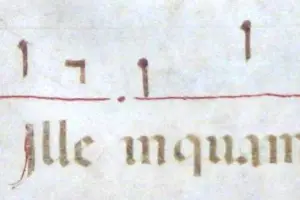
In early written music, music notes were called neumes. They are small dots that show mostly pitch and some duration through a system of symbols. The neume system was used in Eastern and Western music as musical notation prior to the invention of the five-line staff, according to Wikipedia.
Over time, neumes began to be written below, above, or on a single line. This helped identify pitch. Neumes written below the line were lower in pitch than those written on or above the line.
It wasn’t until 1,000 AD when many more advancements were made by Guido of Arezzo.
Who is Guido of Arezzo?
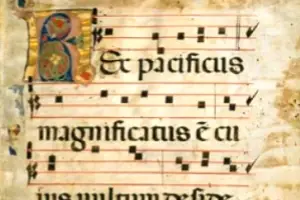
A Benedictine monk, Guido d’Arezzo, increased the lines of the early staff to four. Then, a fifth line was added.
He also invented the Guidonian Hand which helped a larger choir of monks sing together and memorize longer sections of music. Arezzo would hold up his hand and point to specific places on his fingers that represented a specific note. It was basically using the fingers of his hand as a staff with notes placed upon it.
Guido of Arezzo has been given credit as the inventor and developer of the modern music staff notation. This had a major influence on the development of Western music notation. His medieval treatise on music called Micrologus has been the most widely dispersed after Boethius.
Arezzo developed “ut–re–mi–fa–sol–la” which is now called do–re–mi–fa–so–la. This mnemonic was developed to help remember syllables that represent each note of the musical scale. According to Wikipedia, this form of solmization developed into solfège within Western culture.
What is Solfège?
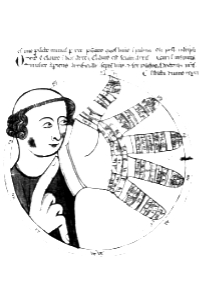
Solfège of solfeggio is a type of singing exercise without text. Scales, intervals, and melody lines were sung using solmization syllables. The evolution of the Guidonian syllables turned into the modern usage of do, re, mi, fa, so, la, ti. Those syllables were applied to notes in the same way as letter names using fixed do.
Here is a list of fixed do solfège music letter names.
- Do = C
- Re = D
- Mi = E
- Fa = F
- So = G
- La = A
- Ti = B
Solfège is still used today as training for sight-reading and sight-singing. Many countries throughout the world use this system names notes in the same way letters are used to name notes in English. It is helpful for musicians to learn this system as part of their overall education in music note names.
Why Learn Note Names?
Learning the names of notes in music gives you the freedom to play and sing more music that you actually enjoy. When you gain the ability to read music and be able to write it down, more opportunities become available. It will also allow you to collaborate with other musicians as your skills evolve. At the end of the day, it will help you become a better musician.
What is the Musical Alphabet?
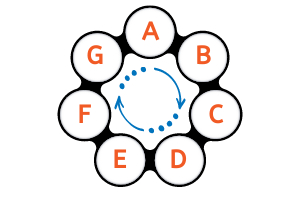
The musical alphabet is used to name music notes. A standardized seven-letter system is used in music to identify pitches.
Only the first seven letters of the American English alphabet are used in the music alphabet. These letters include A, B, C, D, E, F, and G. The letters cycle back to A after G and repeat through the alphabet.
In sheet music, the letter names for music notes are used to identy the pitch of musical notes. The seven letters correspond to the white keys on the piano.
Recommended Reading: The Jackson 5 Guide to the Music Alphabet
What is Pitch?
Pitch is used in music to describe how high or low notes sound or to refer to the sound of a single musical note. Sound is perceived as having a relatively high or low pitch.
The letter names of notes played on an instrument or sung are pitch. Each one has its own unique sound.
In written music, the high or low pitch of a note is determined by its placement on the music staff. The higher the note appears on the staff, the higher the pitch sounds. The lower the note is written on the staff, the lower the pitch sounds.
What is the Music Staff?
A music staff (also called stave) has five horizontal lines and four spaces (between the lines). The five parallel lines are used to write the pitch element of music. Organizing the arrangement of different music notes is made simple using this tool.
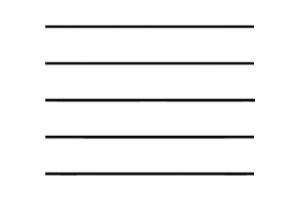
When you write music, you use oval-shaped symbols called notes that are placed on the lines or in the spaces. To musicians, those notes symbolize the sound of pitch.
Starting at the bottom and working your way to the top, the lines and spaces are numbered to indicate the position of a musical note. Numbers 1 to 5 are used for the staff lines with the bottom line numbered as 1.
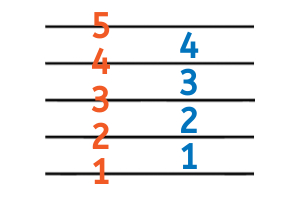
It also shows visually how high or low the pitch of the note sounds when played on an instrument or sung. A note with a high pitch is found at the top of the staff while a low pitch appears towards the bottom.
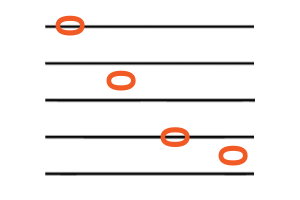
All music staff notes will either be space notes or line notes.
Recommended Reading: The Music Staff: What it is and How to Use it
What are Space Notes?
A space note sits in the space of the staff between the lines. It never crosses over a line. The shape of the note needs to fit exactly in the space.
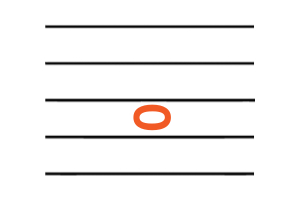
Recommended Reading: Space Notes – What are They Talking About?
What are Line Notes?
A line note is placed right on the lines of the staff. The line runs horizontally through the middle of the note.
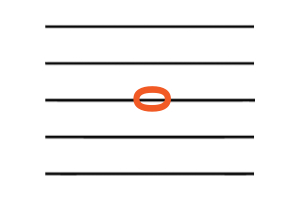
The names of lines and spaces in music are indicated by clef signs.
Recommended Reading: What Exactly are Line Notes?
Clef Signs
Notes are organized on the staff using clef signs. The names of the notes on the staff are determined by the use of clefs. This makes it much easier to read the notes.
A clef is used to show where the note names will appear on the lines and spaces of the staff. You can always find the clef sign at the very beginning of the staff.
This is our guide to knowing the names of music notes on each type of staff. It all depends on which clef sign is used.
Why Use Multiple Clefs?
The purpose of using multiple clefs is to keep as many notes on the staff as possible, making it easier to read. It is much harder to read ledger line notes extended above and below the staff. The use of multiple clefs makes it possible to write more notes on the staff with the least amount of ledger lines.
Each clef sign moves notes to a different position on the staff. To ensure the majority of notes remain on the staff, we swap out the clef signs. Using different clefs makes reading musical notes and their names easier.
Treble Clef Sign
For higher pitched notes, the treble clef symbol is used. The treble clef is also called the G clef because it was first used as a fancy looking “G” symbol.
The “belly” or largest swirled circle of the G-clef curls around the second line (from the bottom) of the staff. This is the starting position for note names on the treble clef staff. All other notes are named from this point in the order of the musical alphabet.
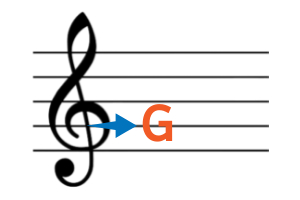
Since “G” is the last letter of the alphabet, the note names will start over with the letter “A” and cycle through in order. After “G,” begins the letter “A” followed by B, C, D, E, F, and G on the lines and spaces of the staff.
No spaces or lines are skipped. The note names are placed on each line and the very next space using the exact order of the music alphabet.
What are the Note Names for the Treble Clef?
The treble clef note names from bottom to top follow the order of the musical alphabet. Those letters in order are A, B, C, D, E, F, and G.
What are the Note Names for the Lines in Treble Clef?
The names of the line notes on the treble clef staff starting at the bottom and moving towards the top are E, G, B, D, and F. An easy mnemonic device to help you remember the treble clef line notes is Every Good Boy Does Fine.
What are the Note Names of the Spaces of the Treble Clef?
The names of the space notes on the treble clef staff starting at the bottom and moving towards the top are F, A, C, and E. Notice how those letters in the exact order spell the word “FACE.” This is a great way to remember the names of the treble clef space notes.
Here are the alphabetical treble clef note names.
Which Instruments Use the Treble Clef?
The higher range of note names in treble clef are read by those who play high-sounding instruments such as piccolo, flute, clarinet, saxophone, oboe, English horn, violin, trumpet, horn, cornet, xylophone, vibraphone, recorder, mandolin, guitar, and bagpipes. A woman’s voice can also sing these higher pitches.
Bass Clef Sign
For lower pitched notes, the bass clef symbol is used. The bass clef is also called the F clef because it was first used as a fancy looking “F” symbol.
The ear-shaped F-Clef starts on the fourth line of the staff. A dot is also placed both above and below the fourth line. The purpose of the dots is to assign the letter name “F” to this line.
By the way, this type of bass is not a type of fish. It is pronounced base.
What are the Note Names for the Bass Clef?
The bass clef note names from bottom to top follow the order of the musical alphabet. Those letters in order are A, B, C, D, E, F, and G.
What are the Note Names for the Lines in Bass Clef?
The names of the line notes on the bass clef staff starting at the bottom and moving towards the top are G, B, D, F, and A. An easy mnemonic device to help you remember the bass clef line notes is Good Boy Does Fine Always.
Notice how similar this is to the line notes of the treble clef? Just leave out the word “Every” at the beginning and add the word “Always” at the end to help you memorize this mnemonic device faster.
What are the Note Names of the Spaces of the Bass Clef?
The names of the space notes on the bass clef staff starting at the bottom and moving towards the top are A, C, E, and G. An easy mnemonic device to help you remember the bass clef space notes is All Cows Eat Grass.
Here are the alphabetical bass clef note names.
Which Instruments Use the Bass Clef?
The lower range of bass clef notes are read by those who play low-sounding instruments such as trombone, tuba, bassoon, contrabassoon, electric bass, timpani, cello and double bass. A man’s voice can also sing these lower pitches.
C Clefs
The C clef symbol shows where the pitch “C” is on the staff. It got its name from the two backward C’s stacked on top of each other. The middle area where the two C’s connect indicates what line or space is designated as “C.”
There are multiple C clefs that each position the note “C” differently. The most common types of C clef staves still used today are the alto clef and tenor clef.
Alto Clef
The alto clef is a type of C clef positioned on the third line of the staff (from the bottom). The middle section where the two C’s connect in the C clef symbol indicates a note placed on the third line of the staff is “C.”
Viola players almost always use the alto clef when reading note names in music. Occasionally, trombone and bassoon players do also.
You may notice the positioning of C on the alto clef is right in the middle when compared to the treble clef and bass clef staves. This fits the middle range pitches of the viola perfectly by keeping notes mostly written on the staff. Using other clefs instead would create more ledger lines making it tougher to read.
Here are the alto clef note names.
Tenor Clef
The tenor clef is a type of C clef positioned on the fourth line of the staff (from the bottom). The middle section where the two C’s connect in the C clef symbol indicates a note placed on the fourth line of the staff is “C.” Bassoon and trombone players sometimes read tenor clef, but most today use bass clef instead.
Here are the tenor clef note names.
What is the Grand Staff?
The grand staff uses both the bass clef staff and the treble clef staff. The treble clef is on top and the bass clef sits below. They are connected by a squiggly brace (or bracket) that looks like a side-ways mustache.
With the grand staff, you can see how the low and high notes are connected with a shared middle C. The cyclical repeating pattern of the musical alphabet uses a wider range of music notes and names.
Piano, organ, synthesizer, harp, vibraphone, xylophone, and marimba players read the notes on both staves at the same time from left to right. This is because of the large range between high and low notes on the instruments. You may also see this occasionally in vocal music and in a piano score, which is a reduced full score for conductors.
This is unique because your eyes read notes both horizontal and perpendicular together. Reading a book only requires reading words horizontally. If you want to strengthen your reading skills, try reading notes on the grand staff. The same area of the brain is used in both situations making you extremely smart.
On piano, the right hand plays the treble clef notes while the left hand mostly plays the bass clef notes. The lower notes on the keyboard move from middle C down towards the left. The higher notes on the piano start at middle C and move up towards the right. The different types music notes on both clefs are played at the same time using both hands.
It is important to note that some books and textbooks refer to the grand staff as the “great staff.”
Grand Staff Note Names
The grand staff note names consist of both treble clef and bass clef notes. The different types of notes are always read from the bottom to the top following the order of the music alphabet.
Here is the alphabetical grand staff with note names.
What are Ledger Lines?
The short horizontal lines above and below the staff are called ledger lines. Their purpose is to extend the pitch range of the staff. When notes are too high or too low to be written on the staff, ledger lines are added.
Notes can be placed on the lines of the ledger lines or in the spaces between the ledger lines. Each line or space between the ledger lines is designated for a single note.
The ledger lines are never connected to the surrounding notes. They are the same length horizontally as the note they are attached to. You will never see them indicate a note.
Multiple ledger lines can be added to a staff to extend both the higher and lower pitch ranges when needed. These extra lines are temporary and not added permanently. They can also be used with any clef sign.
Ledger Line Note Names
Middle C is the most commonly known ledger line note. It is shared by both the treble clef and bass clef staves of the grand staff.
The middle range pitch notes B, C, and D of the grand staff can be written using ledger lines in both the bass and treble clef staves. Although, they are typically chosen to be written in one or the other and not both at the same time. Choosing just one staff for the middle sounding notes to appear makes it easier to read in the grand staff.
Treble Clef Ledger Line Note Names
The treble clef ledger line note names continue to follow the order of letter names in the musical alphabet. The higher the notes are placed on the ledger lines or in the spaces between those lines, the higher the sounding pitch.
Here is an example of treble clef ledger line notes.
Bass Clef Ledger Line Note Names
The bass clef ledger line note names also continue to follow the order of letter names in the musical alphabet. The lower the notes are placed on the ledger lines or in the spaces between those lines, the lower the sounding pitch.
Here is an example of bass clef ledger line notes.
Grand Staff Ledger Line Notes
Grand staff ledger line notes may feel tricky to read at first, but get easier with practice. Once the notes on the staff are mastered, start reading ledger line notes more often.
Here is an example of the grand staff with ledger line notes included.
What are the Note Names on a Piano?
It is easier to see the repeating pattern of the musical alphabet on piano keys. Among the white keys are repeating groups of black keys. The two white key group alternates with a group of three black keys.
All of the white keys (A-G) are natural notes. All of the black keys are accidentals (sharps and flats).
The white key directly to the left of two black keys is C. The C in the middle of the piano is called middle C for that very reason.
The white key directly to the left of three black keys is F. The notes C and F are anchor notes on the piano because they are the easiest to find.
The white keys continue to move forward in the alphabet in order until the letter “G.” Then, the note names on piano start over with A and continue through the repeating pattern of music note names.
What are Half Steps?
Half steps are the distance from one piano key to the very next piano key above or below. Another way of thinking about it is as two adjacent keys on the piano. It must be the closest key which can be either a white key (if no black key is in between) or a black key.
The white keys adjacent to each other are B, C, E, and F. Since there are no black keys in between the two groups of white keys (B to C and E to F) on the keyboard, that distance of movement is a half step.
This means B to C equals a half step and so does E to F. These are called natural half steps because they are the only names of musical notes that naturally occur on the keyboard without black keys in between the white keys.
What are Accidentals?
Accidentals are used to raise the pitch of a note, lower the pitch, or return it to its normal pitch. The term is used to describe any pitch that is not a natural note or white key.
The different types of accidentals include sharps, flats, natural signs, double sharps, and double flats. They are added in front of the letter note name on the music staff in the same space or line of the note it alters. When notes are on ledger lines, accidentals appear in front unattached to the ledger line.
The names of the black keys represent all accidentals and take the letter name from the adjacent white key. The white keys B, C, E, and F can also be accidentals.
Accidental signs attached to notes on the staff affect the following same letter name notes in that measure only. After the bar line, all accidentals in the previous measure are cancelled with only one exception. If a note is tied across the bar line, the accidental will carry through to the next measure.
The only way to cancel a sharp or flat is to use a natural sign.
What are Sharps?
A sharp sign raises the pitch of a note one half step. It looks like the pound sign on the computer keyboard (shift + 3). The adjacent black key to the right of a white key is the sharp note.
Find C on the keyboard. Now move to the very next black key to the right of C. This key is C sharp.
On the music staff, a sharp sign is added in front of the letter note name. The little box in the middle of the sharp sign is centered on the line if it is attached to a line note or centered in the space when attached to space notes.
In contrast, the sharp symbol is added after the letter name on paper, so it reads C# (and not #C). When we speak, we say the word “sharp” after the letter name as well.
What are Flats?
A flat sign lowers the pitch of a note one half step. It looks like a lowercase italicized letter b. The adjacent black key to the left of a white key is the flat note.
Find D on the keyboard. Now move to the very next black key to the left of D. This key is D flat.
On the music staff, a flat sign is added in front of the letter note name. The round belly of the flat sign is centered on the line if it is attached to a line note or centered in the space when attached to space notes.
In contrast, the flat symbol is added after the letter name on paper, so it reads Db (and not bD). When we speak, we say the word “flat” after the letter name as well.
Did you notice that C# and Db use the same black key on the piano? This is a great example of an enharmonic note.
What are Enharmonic Notes?
Enharmonic notes are two notes that sound exactly the same, but have different letter names. They also share the same piano key.
One half step above C is C sharp. One half step below D is D flat. C sharp and D flat are the same pitch and share the same key on the piano. Therefore, C sharp and D flat are enharmonic notes.
As you may have noticed, all black keys have two names. Here is the complete list of black key enharmonic notes:
C# is the same pitch and piano key as Db
D# is the same pitch and piano key as Eb
F# is the same pitch and piano key as Gb
G# is the same pitch and piano key as Ab
A# is the same pitch and piano key as Bb
White keys can also have enharmonic note names. One half step above B is B sharp. One half step below C is C flat. The white key B sharp is enharmonic with the white key C flat.
The following enharmonic notes move one half step up or down from one white key to another white key.
Cb is the same pitch and piano key as B
Fb is the same pitch and piano key as E
E# is the same pitch and piano key as F
B# is the same pitch and piano key as C
A sharp, flat, or natural carries through to other notes with the same name within the same measure unless a natural sign is used.
For example, a B that appears after a Bb in the same measure will also be played as Bb.
The note C that appears after a C# in the same measure will also be played as C#.
An F§ that appears after an F# in the same measure will also be played as F§ or just F.
The only exception to this rule is when notes are tied across the bar line.
What are Naturals?
A natural sign cancels a previous sharp or flat. It can either lower or raise the pitch of a note. When a natural cancels a flat, it raises the pitch a half step. The pitch is lowered a half step when used to cancel a sharp. A natural can be used with any note.
The letter names of all white piano keys are considered naturals and called natural notes. All notes with a natural sign attached will always be white keys on the piano.
On the music staff, a natural sign is added in front of the letter note name. The box of the natural sign is centered on the line if it is attached to a line note or centered in the space when attached to space notes.
In contrast, the natural symbol is added after the letter name on paper, so it reads D natural (and not natural D). When we speak, we say the word “natural” after the letter name as well.
A natural symbol is used in sheet music to cancel an accidental that appeared earlier in the same measure between the bar lines. In other words, it allows the note to go back to its natural letter name or return to its normal pitch.
What are Double Sharps?
A double sharp raises a sharp note one half step. The x symbol is used to indicate the note has now been raised a total of two half steps while keeping the same letter name.
Think of it as sharping the note twice (double sharp). On the piano, this is moving 2 keys to the right.
Find C# on the keyboard. Now move to the very next key to the right of C#. This white key is C double sharp.
On the music staff, a double sharp sign is added in front of the letter note name. In contrast, the double sharp symbol is added after the letter name on paper, so it reads Cx (and not xC).
Did you notice that Cx and D use the same piano key? They are enharmonic with each other.
What are Double Flats?
A double flat lowers a flat note one half step. The bb symbol is used to indicate the note has now been lowered a total of two half steps while keeping the same letter name.
Think of it as flatting the note twice (double flat). On the piano, this is moving 2 keys to the left.
Find Db on the keyboard. Now move to the very next key to the left of Db. This key is D double flat.
On the music staff, a double flat sign is added in front of the letter note name. In contrast, the double flat symbol is added after the letter name on paper, so it reads Dbb (and not bbD).
Did you notice that Dbb and C use the same piano key? They are enharmonic with each other.
Enharmonic Notes on the Piano
Enharmonic notes sound the same but are written differently. They are used in written music for all instruments and voice.
Here are all the enharmonic names for the keys on the piano.
C# is the same pitch and black piano key as Db
D# is the same pitch and black piano key as Eb
F# is the same pitch and black piano key as Gb
G# is the same pitch and black piano key as Ab
A# is the same pitch and black piano key as Bb
Cb is the same pitch and white piano key as B
Fb is the same pitch and white piano key as E
E# is the same pitch and white piano key as F
B# is the same pitch and white piano key as C
A half step up from C is C#. This key can also be called Db because it is also a half step down from D.
C# is the same pitch and black piano key as Db
(Do I want to change it to this writing format in this section?)
A half step up from B is B# which is also called C. A half step below C is Cb which is also called B.
What are Whole Steps?
One whole step is equal to two half steps. It is the distance of counting two keys away from your starting key. They must be the closest keys above or below which can be either a white key (if no black key is in between) or a black key.
This is easier to visualize this on the piano.
Start on C and move up one half step to C#. Now move up another half step to Cx or D. That movement from C to D is two half steps or one whole step. So, C to D is one whole step.
An easier way to see this is to check the piano keys to see if there is one key in between the two notes. If there is, then the distance between those two notes is a whole step. It takes two half steps in total to get there.
Look at the enharmonic names for the keys on the piano again.
A whole step up from C is D. A whole step down from G is F.
A whole step up from E is F#. A whole step down from G# is also F#.
What is a Scale?
A scale is a series of notes arranged in a specific order of half steps and whole steps. As the notes of the scale ascend, the pitch gets higher. As the notes of the scale descend, the pitch gets lower.
On the music staff, line and space notes alternate when written as a scale. The line-space-line-space alternating note pattern repeats as the pitch gets higher and lower.
The names of notes in a scale can also include flats and sharps. This ordered system of pitches is used as the basis of a composition.
The fundamental pitches of a piece of music are from a scale, which ranges from low to high or high to low. Every song, melody, or musical piece uses at least one scale as the foundation of its creation. This also defines the key of the music.
What is Melody?
An arrangement of different notes into an identifiable unit is called a melody. In general, the more skillfully notes are put together into a melody, the more we are attracted to it. Simple notes can create an overwhelming emotional experience.
The individual notes that build a melody are pitches. As mentioned earlier, each musical pitch can be referred to by a letter name.
Melodies gravitate around a central pitch called the tonic. The tonality of a piece of music is based on the organization around a central tone or tonic. Very often, the beginning and ending note of a simple song are the same.
If a C scale was used to write a song, the first and last note would likely be C. The tonic or tonality of the song is C.
What is a Key?
A key in a composition is the tonal center that is built on the tonic note of a scale. When writing music, the basic tonal system used is a scale.
How Many Note Names are There?
In total, there are 12 note names. This includes 7 natural notes and 5 enharmonic notes.
As discussed earlier, the 7 natural notes are from the musical alphabet and include A, B, C, D, E, F and G. The 5 enharmonic notes are those same 7 notes with a flat or sharp added.
The 5 Enharmonic Notes
A# or Bb
C# or Db
D# or Eb
F# or Gb
G# or Ab
With a sharp or flat added, this gives us a total of 12 music note names that are repeated.
This also follows the keyboard. Each section of the piano is a repeating pattern of 12 keys which includes 2 black keys, 3 black keys, and 7 white keys.
2 black keys + 3 black keys = 5 black keys (enharmonic notes)
5 black keys + 7 white keys (natural notes) = 12 note names total
This repeating pattern of 12 note names occurs 7 times across the keyboard. What is helpful is that you only need to remember 7 letters total. That is it!
How to Remember Note Names
Mnemonics are a great way to remember note names. You have learned a few already, but get creative and make up some more. The funnier or wackier it is, the easier it is to remember.
Common Mnemonics for Treble Clef Line Notes
Every Good Boy Does Fine
Every Good Boy Deserves Fudge
Empty Garbage Before Dad Flips
Elvis’ Guitar Broke Down Friday
Elephants Go Backwards Down Freeways
Common Mnemonics for Treble Clef Space Notes
Farting Always Causes Enemies
Fat Alligators Chew Elephants
Frequent Asking Can Enlighten
Flying Aardvarks Create Energy
Common Mnemonics for Bass Clef Line Notes
Good Boys Do Fine Always
Good Burritos Don’t Fall Apart
Grizzly Bears Don’t Fly Airplanes
Grandmas Bake Delicious Fudge Always
Good Bubbles Do Fizz Always
Great Big Dogs Fight Alligators
Goofy Babies Do Funny Acts
Great Bassists Draw Attention
Common Mnemonics for Bass Clef Space Notes
All Cows Eat Grass
All Cars Eat Gas
A Cat’s Eyes Glow
Alligators Cook Everything Gross
How to Memorize Note Names
Practicing music note name flashcards daily helps you memorize note names faster. Start with just 3 cards and add in one more when those three are mastered. Keep adding in one more flash card at a time until you can master all musical notes.
Here is a list of my favorite music flash cards.
At What Point Should I Stop Writing in the Note Names for Music Pieces?
Many teachers will disagree with me, but I have found it helpful for students to write all note names in their music before playing. The exercise of writing in the names of notes is excellent practice in and of itself.
An association between letter names and note placement on the staff develops over time with practice reading. You next step is to slowly erase (or don’t write in) letter names that you become familiar with. For example, once you can recognize middle C easily, there is no need to continue writing the letter name next to the note in your music.
Reading Note Names in Music Summary
Learning to read music is an essential part of mastering any instrument. It allows you to not only read names of the music notes you are playing, but to read music that others are creating and playing. Knowing how to read music is a valuable asset to have in your toolbox while learning how to play an instrument. It can seem daunting at first, but with the right musical tools and guidance, you can learn to read music in no time.
